EDLDR: An Ensemble Deep Learning Technique for Detection and Classification of Diabetic Retinopathy
Abstract
1. Introduction
2. Literature Review
3. Proposed Method
3.1. Input Retinal Images
3.2. Pre-Processing of Images
| Algorithm 1: Histogram equalization algorithm. |
| Input—Retinal images |
| Output—Preprocessed histogram equalized image |
| Method: CLAHE |
| Begin |
| For each image compute: |
| where is the pixel value at location for the |
| image |
| End |
3.3. Data Augmentation
3.4. ResNeXt Model
3.5. DenseNet Model
3.6. Ensemble Architecture
- (a)
- Maximum probability-based cross entropy loss: For improving the training of the model, MPCE loss function is used. It reduces the back propagation error and makes the convergence fast. The mathematical formulation of MPCE is shown in Equation (3).
3.7. Model Training
3.8. Rectified Adam Optimization
3.9. Grad-CAM Visualization
4. Results and Discussion
4.1. Dataset Used
4.1.1. Two Class Databases
4.1.2. APTOS 2019
- Precision is defined as the number of misclassifications. This can be computed by
- Recall is a measure of the actual positives a model computes. The formula for computing the recall is shown in Equation (6):
- The overall accuracy is also computed using
4.1.3. Two Class Detection
4.1.4. Five Class Detection
- 0
- No DR (NDR)
- 1
- Mild
- 2
- Moderate
- 3
- Severe
- 4
- Proliferative DR (PDR)
5. Conclusions and Future Work
Author Contributions
Funding
Institutional Review Board Statement
Informed Consent Statement
Data Availability Statement
Conflicts of Interest
References
- Kumar, N.C.S.; Radhika, Y. Optimized maximum principal curvatures based segmentation of blood vessels from retinal images. Biomed. Res. 2019, 30, 2. [Google Scholar] [CrossRef]
- Hassan, G.; El-Bendary, N.; Hassanien, A.E.; Fahmy, A.; Snasel, V. Retinal blood vessel segmentation approach based on mathematical morphology. Procedia Comput. Sci. 2015, 65, 612–622. [Google Scholar] [CrossRef]
- Orlando, J.I.; Prokofyeva, E.; Blaschko, M.B. A discriminatively trained fully connected conditional random field model for blood vessel segmentation in fundus images. IEEE Trans. Biomed. Eng. 2016, 64, 16–27. [Google Scholar] [CrossRef] [PubMed]
- Mondal, S.S.; Mandal, N.; Singh, A.; Singh, K.K. Blood vessel detection from Retinal fundas images using GIFKCN classifier. Procedia Comput. Sci. 2020, 167, 2060–2069. [Google Scholar] [CrossRef]
- Memari, N.; Ramli, A.R.; Saripan, M.; Mashohor, S.; Moghbel, M. Retinal blood vessel segmentation by using matched filtering and fuzzy c-means clustering with integrated level set method for diabetic retinopathy assessment. J. Med. Biol. Eng. 2019, 39, 713–731. [Google Scholar] [CrossRef]
- Budai, A.; Bock, R.; Maier, A.; Hornegger, J.; Michelson, G. Robust vessel segmentation in fundus images. Int. J. Biomed. Imaging 2013, 2013, 154860. [Google Scholar] [CrossRef] [PubMed]
- Tian, Z.; Liu, L.; Zhang, Z.; Fei, B. Superpixel-based segmentation for 3D prostate MR images. IEEE Trans. Med. Imaging 2015, 35, 791–801. [Google Scholar] [CrossRef] [PubMed]
- Shankar, K.; Sait, A.R.W.; Gupta, D.; Lakshmanaprabu, S.K.; Khanna, A.; Pandey, H.M. Automated detection and classification of fundus diabetic retinopathy images using synergic deep learning model. Pattern Recognit. Lett. 2020, 133, 210–216. [Google Scholar] [CrossRef]
- Ghosh, R.; Ghosh, K.; Maitra, S. Automatic detection and classification of diabetic retinopathy stages using CNN. In Proceedings of the 2017 4th International Conference on Signal Processing and Integrated Networks (SPIN), Noida, India, 2–3 February 2017; IEEE: Piscataway, NJ, USA, 2017; pp. 550–554. [Google Scholar]
- Gayathri, S.; Gopi, V.P.; Palanisamy, P. A lightweight CNN for Diabetic Retinopathy classification from fundus images. Biomed. Signal Process. Control 2020, 62, 102115. [Google Scholar]
- Reguant, R.; Brunak, S.; Saha, S. Understanding inherent image features in CNN-based assessment of diabetic retinopathy. Sci. Rep. 2021, 11, 9704. [Google Scholar] [CrossRef] [PubMed]
- Benson, J.; Carrillo, H.; Wigdahl, J.; Nemeth, S.; Maynard, J.; Zamora, G.; Barriga, S.; Estrada, T.; Soliz, P. Transfer learning for diabetic retinopathy. In Proceedings of the Medical Imaging 2018: Image Processing, Houston, TX, USA, 10–15 February 2018; International Society for Optics and Photonics: Bellingham, WA, USA, 2018; Volume 10574. [Google Scholar]
- Gadekallu, T.R.; Khare, N.; Bhattacharya, S.; Singh, S.; Maddikunta, P.K.R.; Ra, I.H.; Alazab, M. Early detection of diabetic retinopathy using PCA-firefly based deep learning model. Electronics 2020, 9, 274. [Google Scholar] [CrossRef]
- Kandel, I.; Castelli, M. Transfer learning with convolutional neural networks for diabetic retinopathy image classification. A review. Appl. Sci. 2020, 10, 2021. [Google Scholar] [CrossRef]
- Gadekallu, T.R.; Khare, N.; Bhattacharya, S.; Singh, S.; Maddikunta, P.K.R.; Srivastava, G. Deep neural networks to predict diabetic retinopathy. J. Ambient. Intell. Humaniz. Comput. 2020, 1–14. [Google Scholar] [CrossRef]
- Shen, Z.; Wu, Q.; Wang, Z.; Chen, G.; Lin, B. Diabetic Retinopathy Prediction by Ensemble Learning Based on Biochemical and Physical Data. Sensors 2021, 21, 3663. [Google Scholar] [CrossRef] [PubMed]
- Reddy, G.T.; Bhattacharya, S.; Ramakrishnan, S.S.; Chowdhary, C.L.; Hakak, S.; Kaluri, R.; Reddy, M.P.K. An ensemble based machine learning model for diabetic retinopathy classification. In Proceedings of the 2020 International Conference on Emerging Trends in Information Technology and Engineering (ic-ETITE), Vellore, India, 24–25 February 2020; IEEE: Piscataway, NJ, USA, 2020; pp. 1–6. [Google Scholar]
- Ali, R.; Hardie, R.C.; Narayanan, B.N.; Kebede, T.M. IMNets: Deep Learning Using an Incremental Modular Network Synthesis Approach for Medical Imaging Applications. Appl. Sci. 2022, 12, 5500. [Google Scholar] [CrossRef]
- Kobat, S.G.; Baygin, N.; Yusufoglu, E.; Baygin, M.; Barua, P.D.; Dogan, S.; Orhan, Y.; Celiker, U.; Yildirim, H.; Tan, R.-S.; et al. Automated diabetic retinopathy detection using horizontal and vertical patch division-based pre-trained DenseNET with digital fundus images. Diagnostics 2022, 12, 1975. [Google Scholar] [CrossRef] [PubMed]
- Lim, G.; Thombre, P.; Lee, M.L.; Hsu, W. Generative Data Augmentation for Diabetic Retinopathy Classification. In Proceedings of the 2020 IEEE 32nd International Conference on Tools with Artificial Intelligence (ICTAI), Baltimore, MD, USA, 9–11 November 2020; IEEE: Piscataway, NJ, USA, 2020; pp. 1096–1103. [Google Scholar]
- Chollet, F. Xception: Deep learning with depthwise separable convolutions. In Proceedings of the IEEE Conference on Computer Vision and Pattern Recognition, Honolulu, HI, USA, 21–26 July 2017; pp. 1251–1258. [Google Scholar]
- Hitawala, S. Evaluating ResNeXt Model Architecture for Image Classification. arXiv 2018, arXiv:1805.08700. [Google Scholar]
- Kauppi, T.; Kalesnykiene, V.; Kamarainen, J.-K.; Lensu, L.; Sorri, I.; Raninen, A.; Voutilainen, R.; Uusitalo, H.; Kälviäinen, H.; Pietilä, J. The diaretdb1 diabetic retinopathy database and evaluation protocol. BMVC 2007, 1, 1–10. [Google Scholar]
- Aravind Eye Hospital. APTOS 2019 Blindness Detection. Available online: https://www.kaggle.com/c/aptos2019-blindness-detection (accessed on 19 November 2022).
- Kumar, G.; Chatterjee, S.; Chattopadhyay, C. DRISTI: A hybrid deep neural network for diabetic retinopathy diagnosis. Signal Image Video Process. 2021, 15, 1679–1686. [Google Scholar] [CrossRef]
- Sugeno, A.; Ishikawa, Y.; Ohshima, T.; Muramatsu, R. Simple methods for the lesion detection and severity grading of diabetic retinopathy by image processing and transfer learning. Comput. Biol. Med. 2021, 137, 104795. [Google Scholar] [CrossRef] [PubMed]
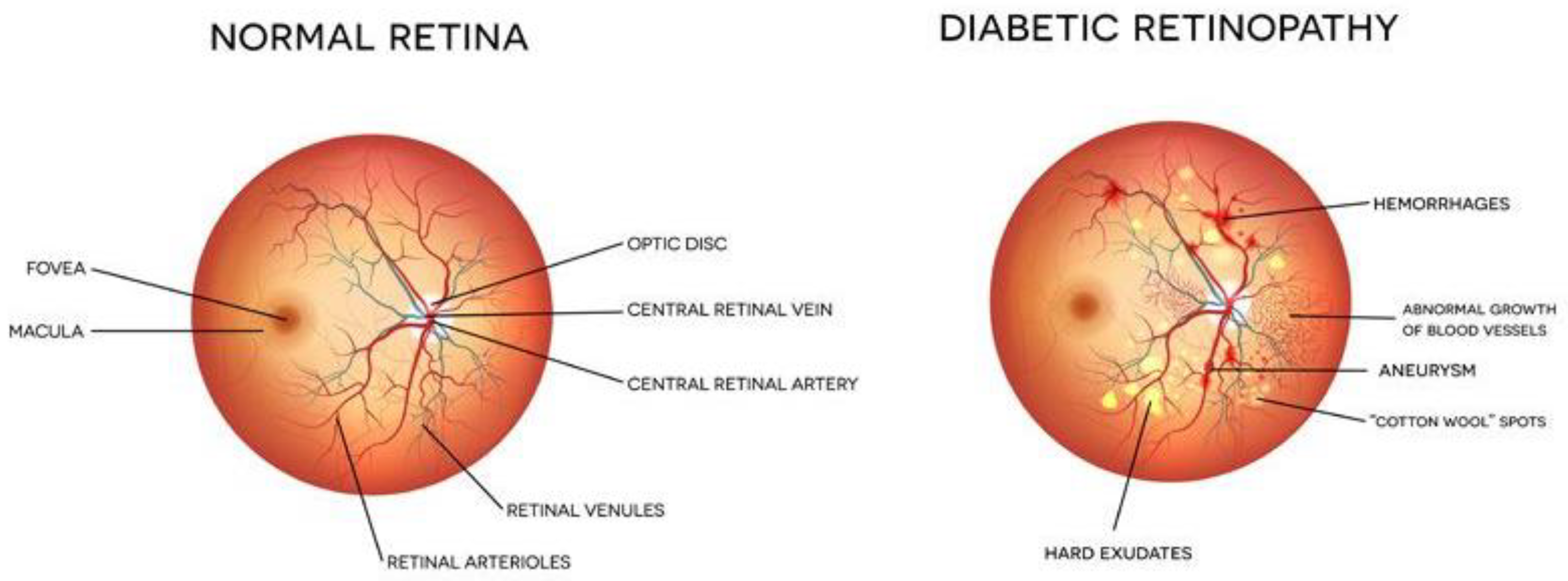
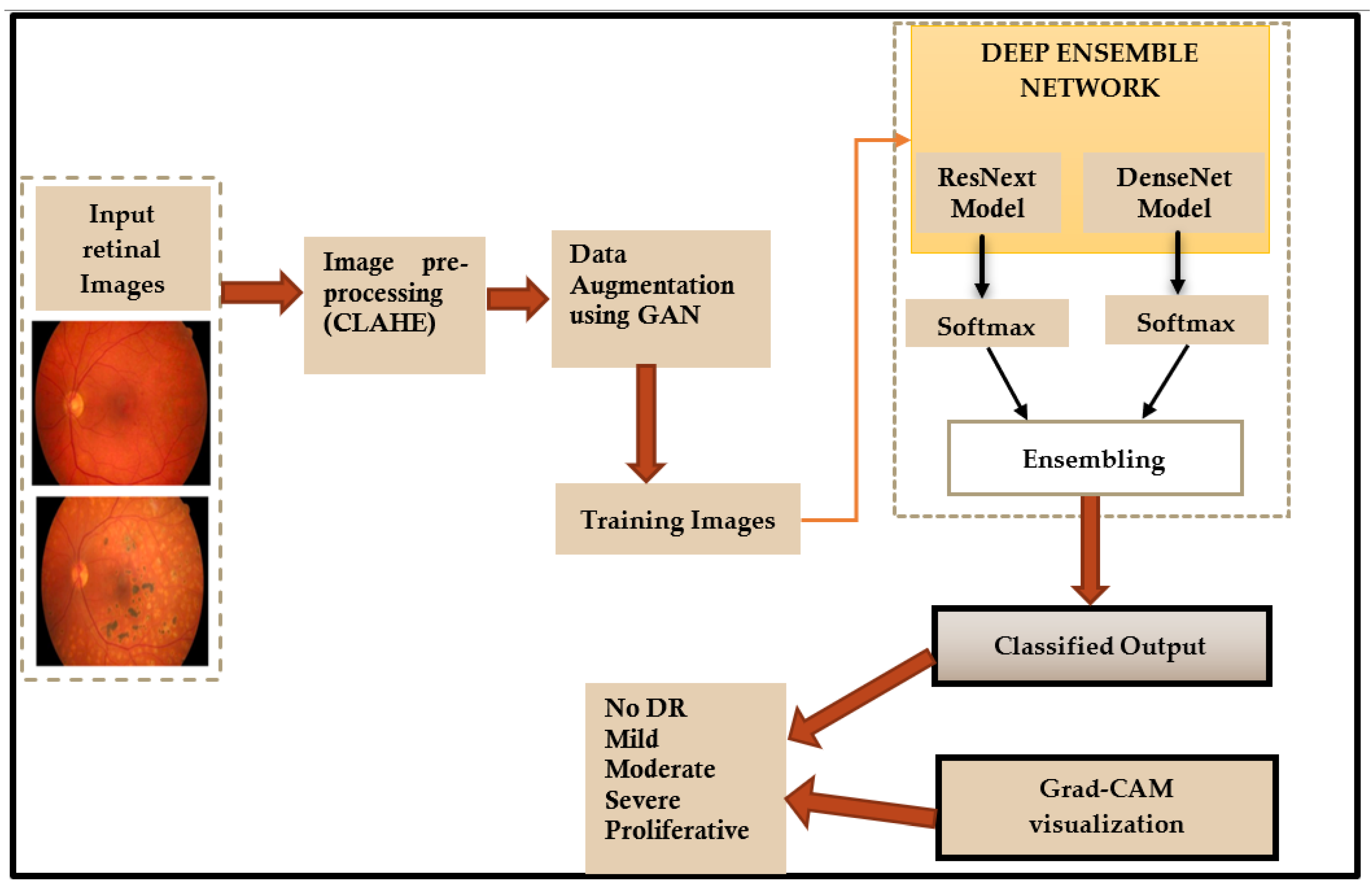
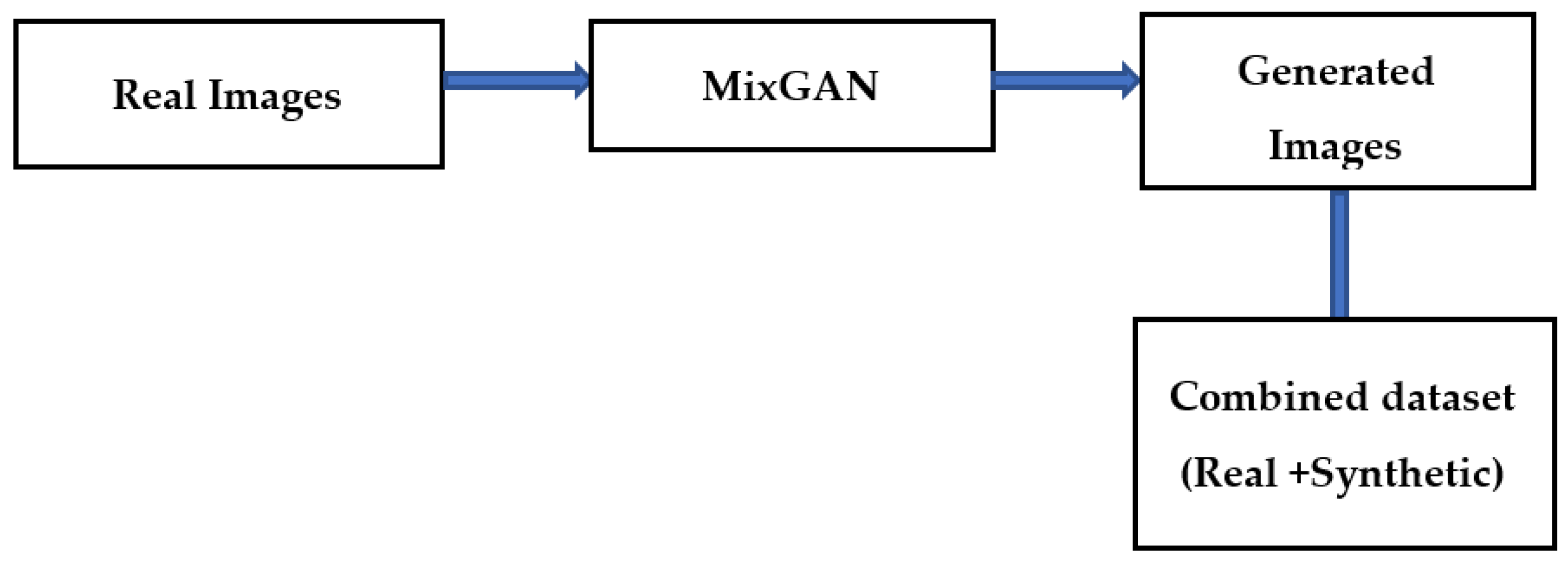
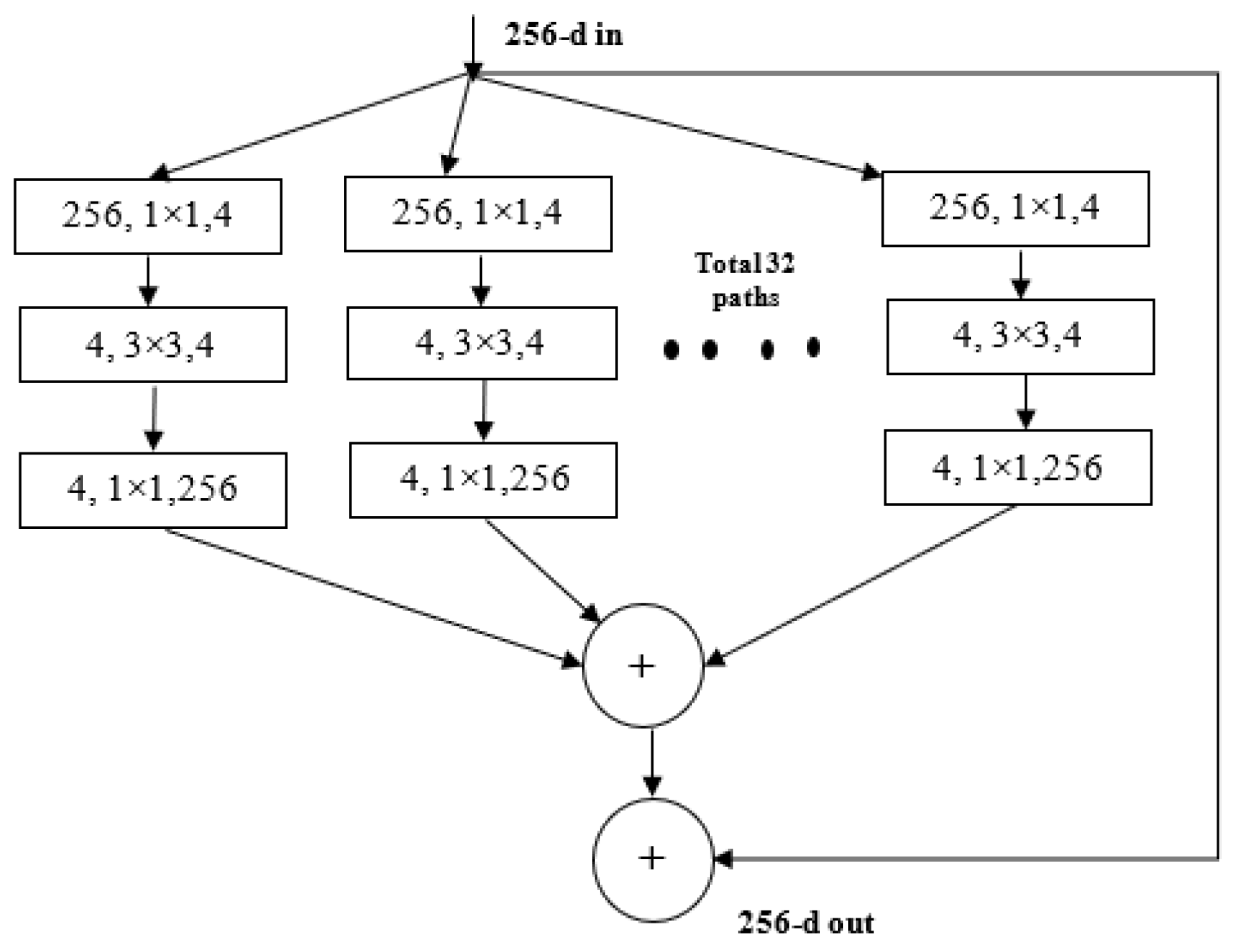
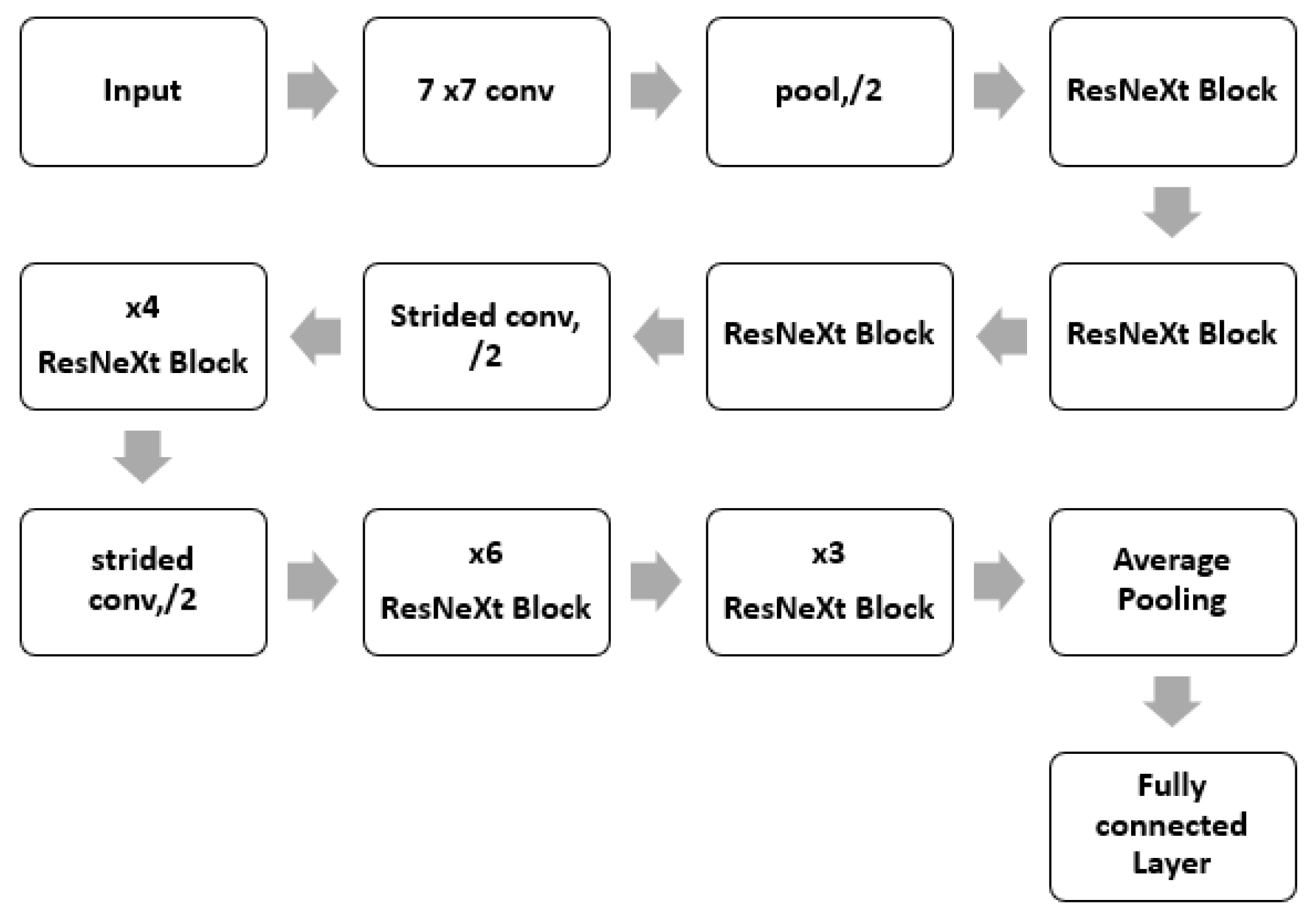
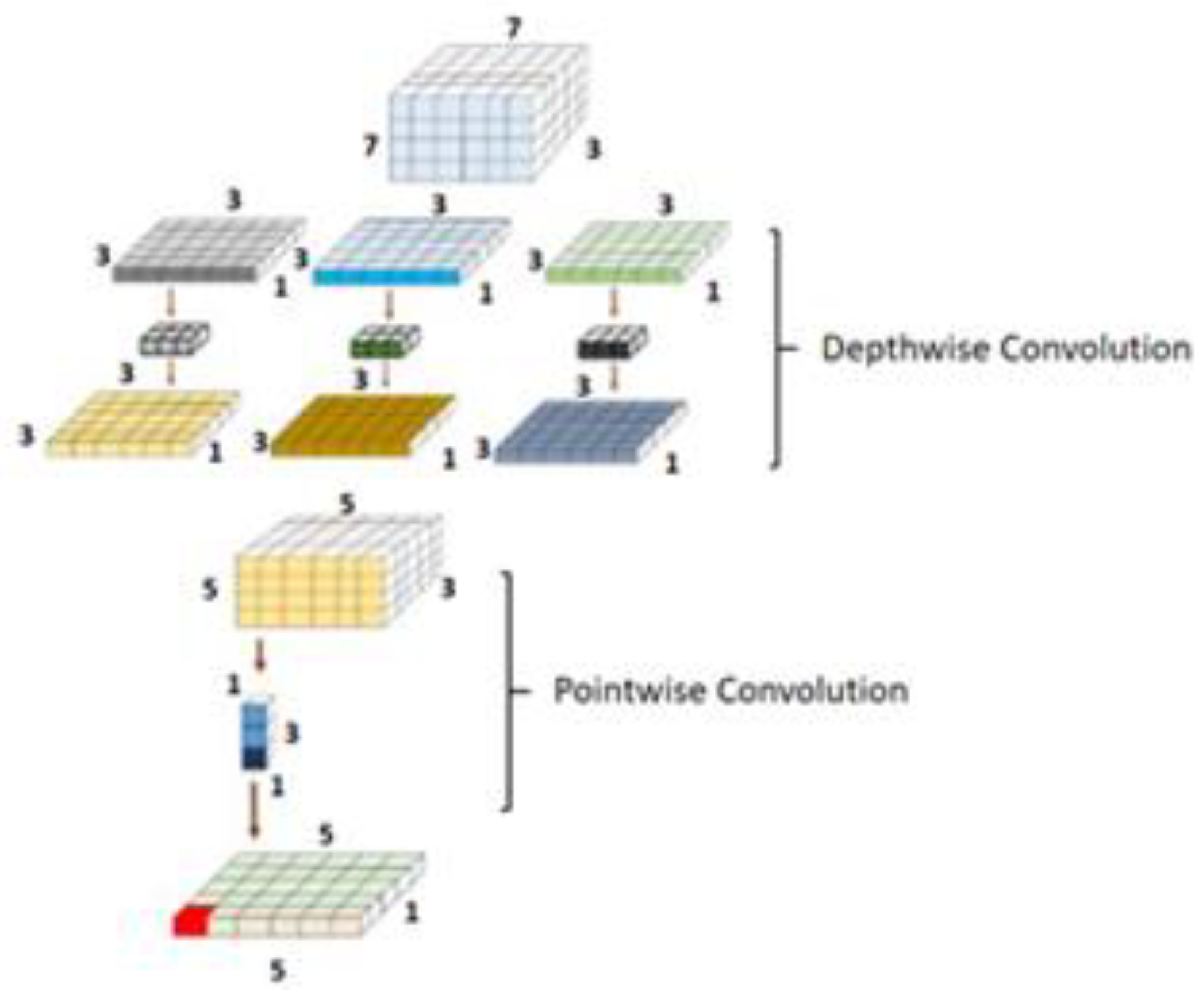
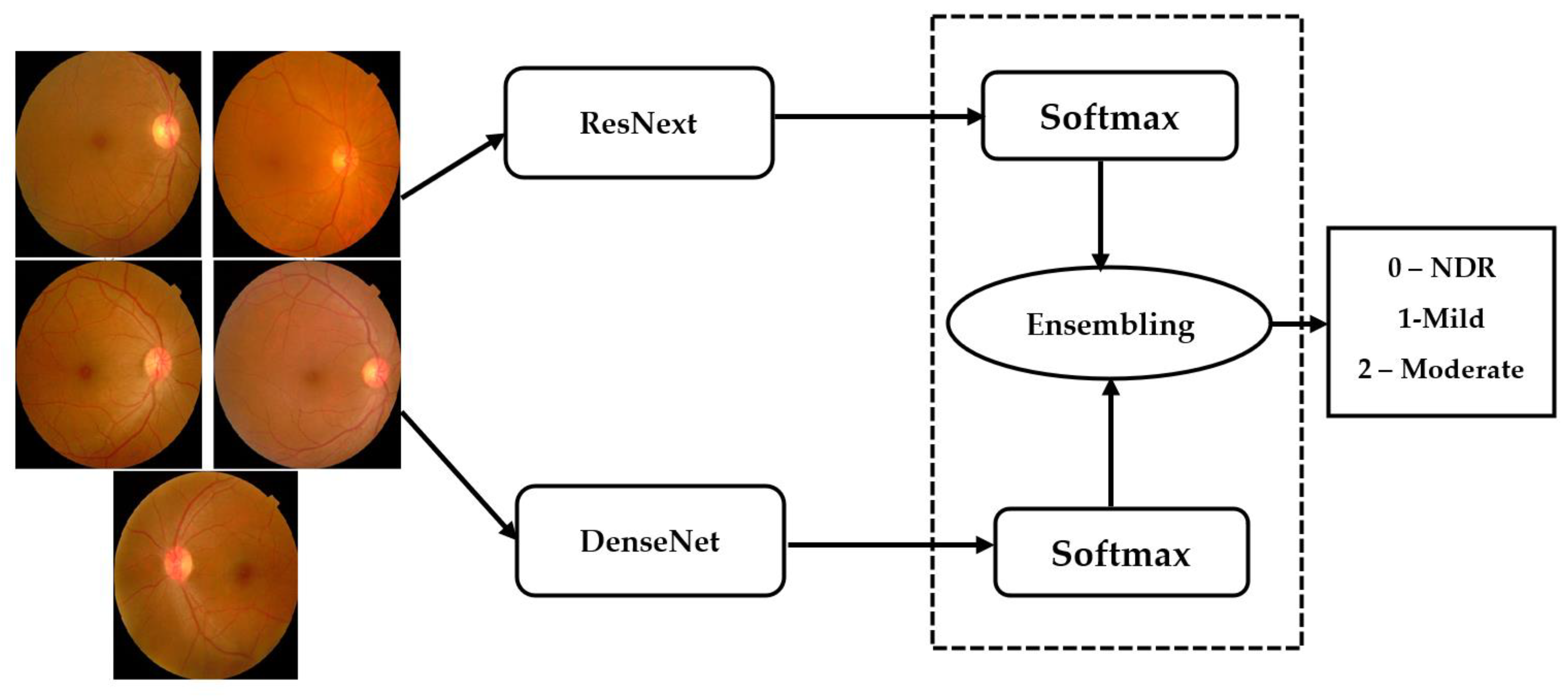
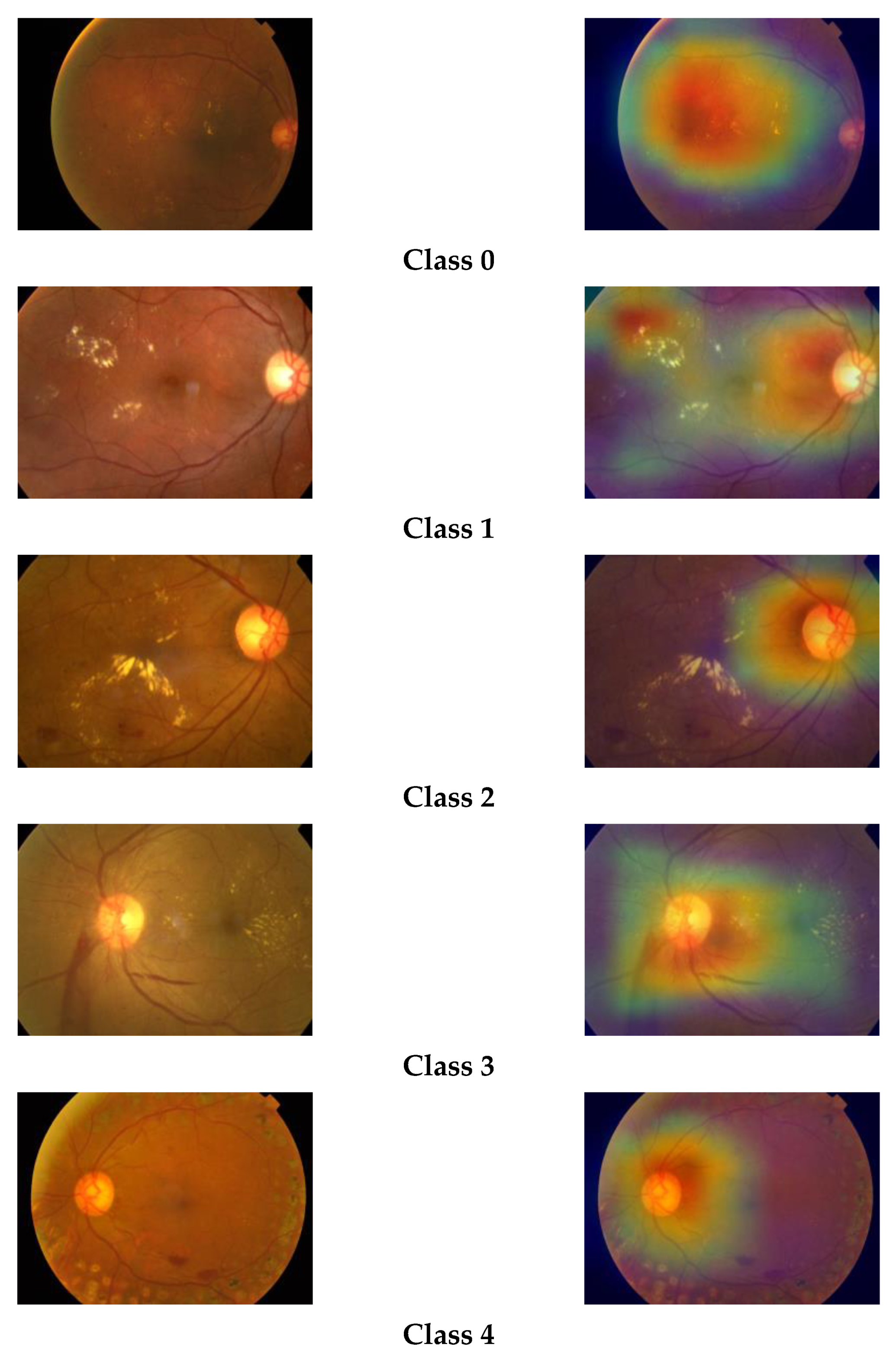
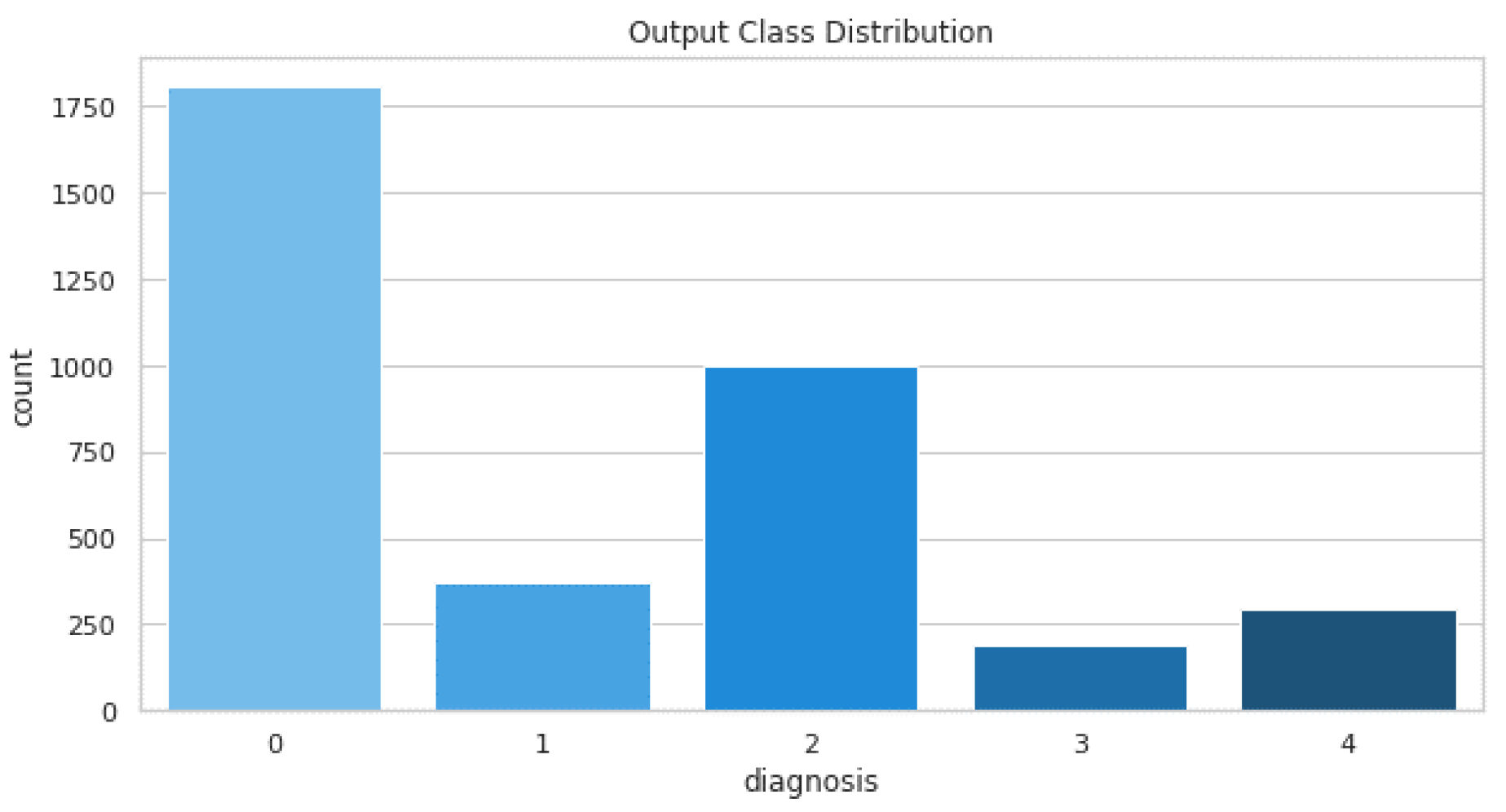
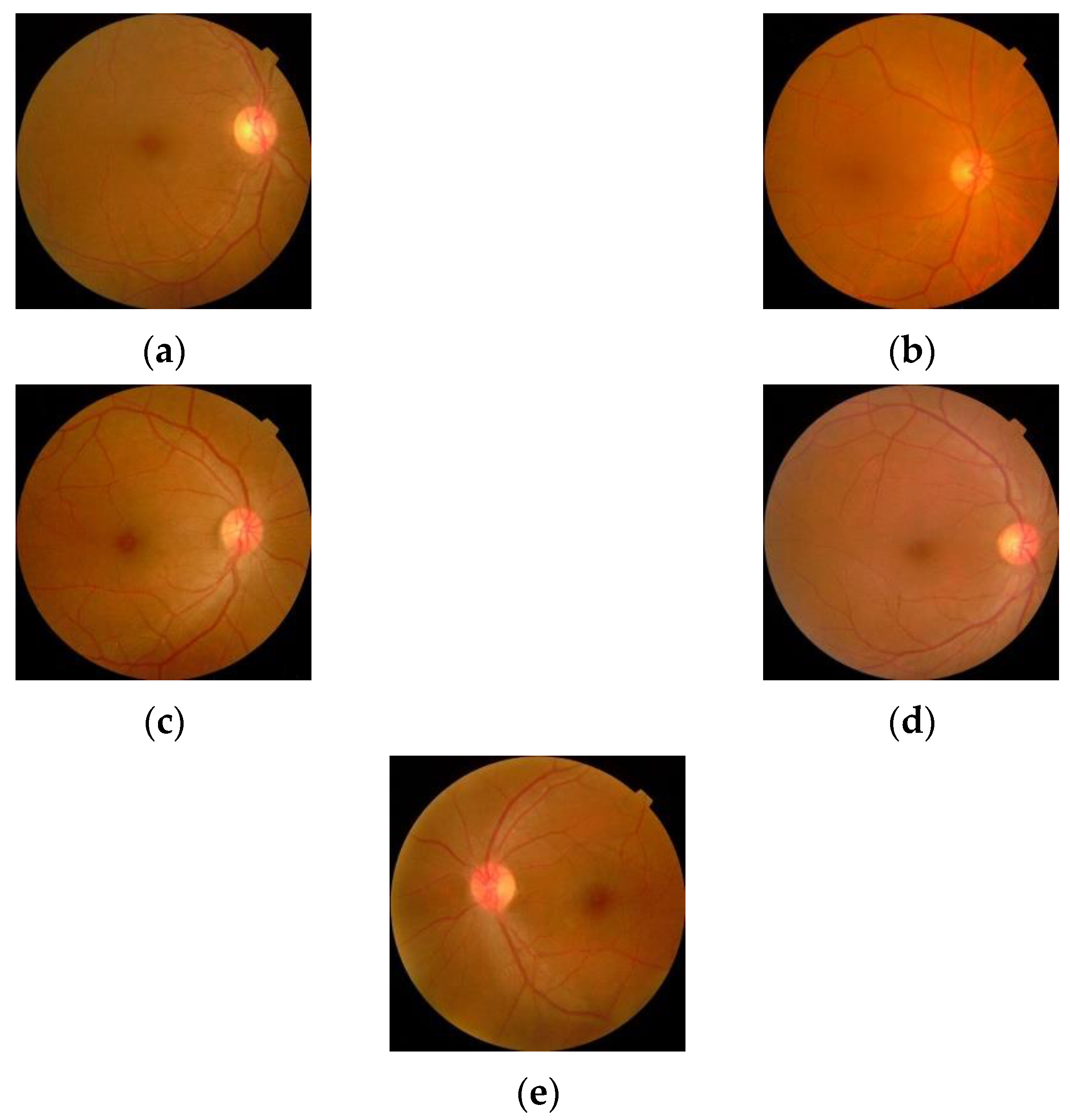
| Layer Type | Output Shape | #Parameters | Kernel Size | Dropout | #Filters |
|---|---|---|---|---|---|
| Input | (224,224,3) | 0 | - | 0 | - |
| Conv2d ×2(RAdam) | (224,224,16) | 448 | 3 × 3 | 0 | 4 |
| Maxpooling 2d | (112,112,16) | 0 | - | 0 | - |
| Seperable Conv2d 2(ReLU) | (112,112,32) | 668 | 3 × 3 | 0 | 32 |
| Batch Normalization | (112,112,32) | 128 | - | 0 | - |
| Maxpooling 2d | (56,56,32) | 0 | - | 0 | - |
| Seperable Conv2d 2(ReLU) | (56,56,64) | 1344 | 3 × 3 | 0 | 64 |
| Batch Normalization | (56,56,64) | 256 | - | 0 | - |
| Maxpooling 2d | (28,28,64) | 0 | - | 0.2 | - |
| Seperable Conv2d 2(ReLU) | (28,28,128) | 2400 | 3 × 3 | 0 | 128 |
| Batch Normalization | (28,28,128) | 512 | - | 0 | - |
| Maxpooling 2d | (14,14,128) | 0 | - | 0.2 | - |
| Seperable Conv2d 2(ReLU) | (14,14,256) | 4736 | 3 × 3 | 0 | 256 |
| Batch Normalization | (14,14,256) | 1024 | - | 0 | - |
| Maxpooling 2d | (7,7,256) | 0 | - | 0.2 | - |
| Seperable Conv2d 2(ReLU) | (7,7,256) | 8896 | 3 × 3 | 0 | 256 |
| Batch Normalization | (3,3,256) | 1024 | - | 0 | - |
| Maxpooling 2d | (3,3,256) | 0 | - | 0.2 | - |
| Seperable Conv2d 2(ReLU) | (3,3,512) | 17,664 | 3 × 3 | 0 | 512 |
| Batch Normalization | (3,3,512) | 2048 | - | 0 | - |
| Maxpooling 2d | (1,1,512) | 0 | - | 0.2 | - |
| FC1(ReLU) | (512) | 262,656 | 0.7 | 512 | |
| FC2(ReLU) | (128) | 65,664 | 0.5 | 128 | |
| FC3(ReLU) | (64) | 8256 | 0.3 | 64 | |
| FC4(ReLU) | (32) | 2080 | 0.2 | 32 | |
| FC5(ReLU) | (5) | 165 | 0 | 5 | |
| Total Params: 1,021,925 Trainable params: 1,019,429 Non-trainable params: 2496 | |||||
| Grade | No. of Images (Training) |
|---|---|
| 0—No DR | 1805 |
| 1—Mild | 370 |
| 2—Moderate | 999 |
| 3—Severe | 193 |
| 4—Proliferative | 295 |
| Predicted | |||
|---|---|---|---|
| Actual | NDR | DR | |
| NDR | 29 | 2 | |
| DR | 3 | 27 | |
| Grade | Testing Images |
|---|---|
| 0—No DR | 353 |
| 1—Mild | 87 |
| 2—Moderate | 205 |
| 3—Severe | 40 |
| 4—Proliferative | 48 |
| Total | 733 |
| Predicted | ||||||
|---|---|---|---|---|---|---|
| Actual | NDR | Mild | Moderate | Severe | PDR | |
| NDR | 313 | 16 | 8 | 10 | 6 | |
| Mild | 5 | 71 | 6 | 4 | 1 | |
| Moderate | 8 | 8 | 179 | 7 | 3 | |
| Severe | 1 | 3 | 3 | 25 | 8 | |
| PDR | 1 | 1 | 2 | 1 | 43 | |
Disclaimer/Publisher’s Note: The statements, opinions and data contained in all publications are solely those of the individual author(s) and contributor(s) and not of MDPI and/or the editor(s). MDPI and/or the editor(s) disclaim responsibility for any injury to people or property resulting from any ideas, methods, instructions or products referred to in the content. |
© 2022 by the authors. Licensee MDPI, Basel, Switzerland. This article is an open access article distributed under the terms and conditions of the Creative Commons Attribution (CC BY) license (https://creativecommons.org/licenses/by/4.0/).
Share and Cite
Mondal, S.S.; Mandal, N.; Singh, K.K.; Singh, A.; Izonin, I. EDLDR: An Ensemble Deep Learning Technique for Detection and Classification of Diabetic Retinopathy. Diagnostics 2023, 13, 124. https://doi.org/10.3390/diagnostics13010124
Mondal SS, Mandal N, Singh KK, Singh A, Izonin I. EDLDR: An Ensemble Deep Learning Technique for Detection and Classification of Diabetic Retinopathy. Diagnostics. 2023; 13(1):124. https://doi.org/10.3390/diagnostics13010124
Chicago/Turabian StyleMondal, Sambit S., Nirupama Mandal, Krishna Kant Singh, Akansha Singh, and Ivan Izonin. 2023. "EDLDR: An Ensemble Deep Learning Technique for Detection and Classification of Diabetic Retinopathy" Diagnostics 13, no. 1: 124. https://doi.org/10.3390/diagnostics13010124
APA StyleMondal, S. S., Mandal, N., Singh, K. K., Singh, A., & Izonin, I. (2023). EDLDR: An Ensemble Deep Learning Technique for Detection and Classification of Diabetic Retinopathy. Diagnostics, 13(1), 124. https://doi.org/10.3390/diagnostics13010124







